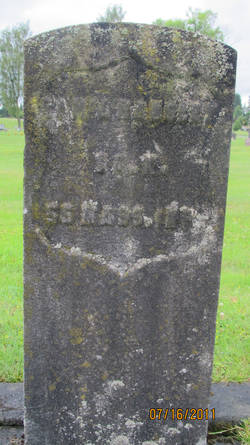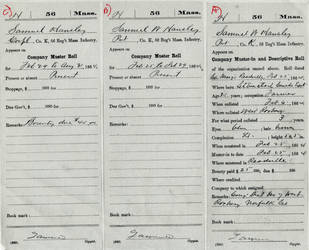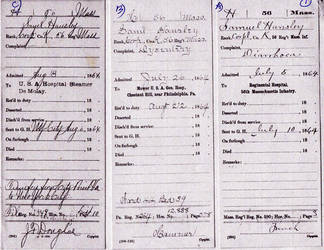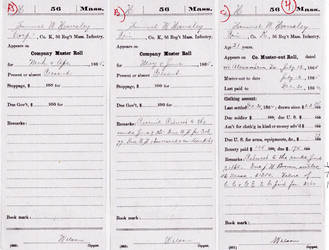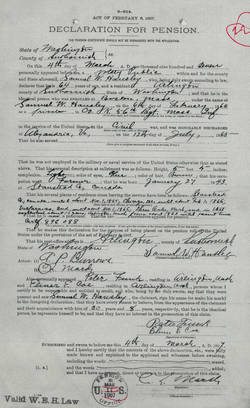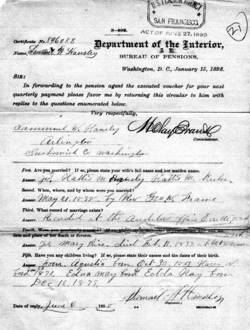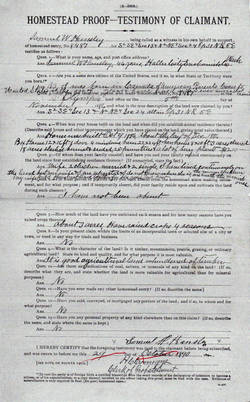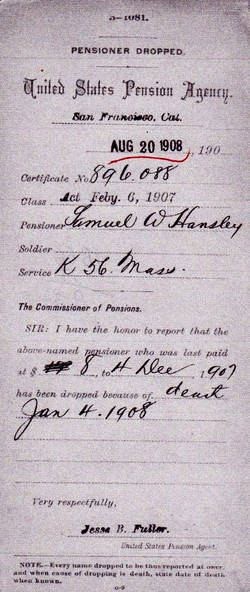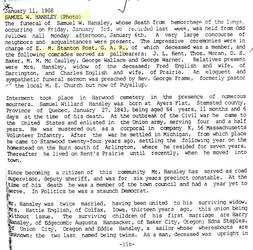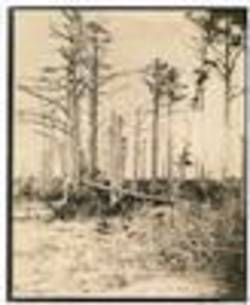Samuel W. Hansley
Representing: Union
G.A.R Post
- E. M. Stanton Post #86 Arlington (Haller City), Snohomish Co. WA
Unit History
- 56th Massachusetts Infantry K
Full Unit History
56th MASSACHUSETTES VOLUNTEER INFANTRY
Organized: Fall/Winter 1863 Camp Meigs, Readville, MA
Mustered In: Dec.'63 and Jan./Feb. '64
Mustered Out: 7/12/65 Alexandria, VA
Discharged: 7/22/65 Readville, MA
Regimental History
REGIMENTAL HISTORY:
The 56th, a three year eastern theater unit was the first "veteran" unit recruited from scratch. A majority of men enlisting in this and other such regiments must have had a least nine months service in some other organization. Four companies of the 56th were mustered into the service just after Christmas, 1863 with others following in January and February, 1864.
The regiment left Massachusetts for Annapolis, MD on 3/20/64. From there, on 4/23/64 it received orders to march to Washington City where it remained two days before, a few days later, heading for the Rappahannock River following the route of the Orange and Alexandria Railroad.
On the fourth of May '64 the unit crossed the Rapidan River at Germanna Ford, VA and followed the rest of the Army of the Potomac into Virginia's Wilderness. Union General U.S. Grant's Overland Campaign which would bring four years of bloody civil War to an end a year later, had begun
All day on the fifth of May the 56th remained within a short distance of the roar and confusion of the raging battle of the Wilderness. The following day it was heavily engaged losing Colonel Griswold and 8 men killed, 57 wounded and 11 missing.
Moving south eastward from the Wilderness, the regiment lost 10 killed 41 wounded and one missing at Spotsylvania. There, during the 5/18 final assault on the Confederate lines it suffered further losses with 5 killed and 40 wounded.
On 5/24, near Ox Ford on the North Anna River the 56th lost another 7 killed, 40 wounded and 17 taken prisoner. Moving from there to Cold Harbor it was in action near Bethesda Church where it lost l killed, 11 wounded and one missing. Three days later it was again engaged losing 2 killed and 7 wounded.
After crossing the James River on 6/15, the 56th participated in the initial assault on the Petersburg lines. There, another 19 were killed, 4 were wounded and 5 went missing. During the six weeks that followed it lost another 6 killed and 22 wounded from the fire of Rebel sharpshooters.
At the "Crater" near Petersburg on 7/3/64 the 56th formed part of the division that lead the advance after the enemy fort was blown up. There it lost another 10 killed 25 wounded and 22 taken prisoner. In less than two months after it crossed the Rapidan the regiment had lost in known and recorded casualties 68 killed, 283 wounded and 57 prisoners.
Still in front of Petersburg, the regiment participated with loss during the 8/19/64 battle of the Weldon Railroad. It suffered further losses on 9/30 at Poplar Grove Church/Peebles' Farm. About the last of November it removed to Fort Davis on the Jerusalem Plank Road where it remained until, December when it was transferred to Ft. Alexander Hays some distance to the left. Here it remained during the winter of 1864-'65.
April 2, 1865. That morning the 9th Corps - which included the 56th - joined in the assault on the Petersburg entrenchments. During this crucial action the 56th carried and held Battery 27 which had been constructed directly in front of Ft. Sedgwick on and across the Jerusalem Plank road. During this assault the regiment lost one captain and two enlisted men killed and another 12 officers and men wounded. With the Confederate line broken, the 56th pursued the enemy as far as Burkesville and there remained until after the surrender of Confed. Gen. Lee and the Army of Northern Virginia at Appomattox Ct. House on April 9th. The regiment was then sent to Alexandria, VA for final muster and from there to Readville, MA for discharge.
Regimental losses: 6 officers killed or mortally wounded; 0 officers died of disease, accidents, etc.; 120 enlisted men killed or mortally wounded; 100 enlisted men died of disease, accidents, etc.
Soldier History
SOLDIER:
Residence: West Roxbury, MA Age: 21.0 yrs.
Enlisted/Enrolled: 2/6/64 Rank: Pvt.
Mustered In: 2/25/64
Mustered Out: 7/12/65 Near Alexandria, VA
Discharged: 7/22/65 Readville, MA
Highest Rank: Cpl. * (see bio)
Family History
PERSONAL/FAMILY HISTORY:
Samuel W. Hansley was born 1/27/43 at Ayers Flat, Stanstead County, Canada East. This region became part of the Province of Quebec when the Dominion of Canada was formed in June of 1867.
Samuel's parents were reportedly American the name of neither appears in available documents. Also, unknown are possible siblings which Samuel may have had.
While Samuel's obituary would later report that he had travelled to the United States at the outbreak of the Civil War, by his own telling in 1900, he arrived here in 1865. Even that, however, is questionable as he was already in this country when, on 2/6/64, at West Roxbury, Norfolk Co., MA - a suburb of Boston - he enlisted as a private in the U.S. Army. With no prior military experience, he was one of the few non-veteran members of his regiment, the 56th Massachusetts infantry. That being said, having enlisted as an inexperienced soldier, Samuel was increased in rank to corporal by the end of February. For enlisting he received a $300 enrollment bonus or "bounty", $25 of which was paid to him up front with the balance of which was to be received in later increments.
Within a few months of enlistment Corporal Hansley and his regiment were moving southward through Virginia as part of Union Gen. U.S. Grant's overland campaign which, within a year would bring an end to four years of bloody civil war. One of the first locations mentioned pertaining to Corporal Hansley in this movement was at Spotsylvania Court House. There, on 5/12 while behind a breastwork, an artillery shell burst on the ground in front of him throwing dirt and gravel into his eyes.
Later that same month as Union forces moved further southward they again grappled with the enemy along the North Anna River. By Samuel's telling, at the North Anna his brigade crossed the river and pushed back enemy pickets to their main line. Then, his brigade was flanked, causing their skirmish line to break and fall back toward and across the river. While on the way back he was struck in the head by a bullet or "something else." He didn't know what. He also didn't know if he was knocked down or not as he was so excited he did not know all that did happen there in the woods as (the Rebels) were shelling the timber very hard all the time. In the excitement and confusion he did not even discover his injury until he got back to the main Union line. The head wound would heal, but left a "very ugly" scar.
Combat aside; during 1864 Corporal Hansley fought a more significant battle with diarrhea and dysentery. On 7/5 the ailment landed him in the regimental hospital, but with his condition not improving, four days later he was transferred to the division hospital. From there, on the 16th, he was moved to another medical facility before, on 7/16, being sent the U.S. general hospital located at City Point, VA. Even there, his medical travails weren't over as he was, on 7/26 moved to Chestnut Hill near Philadelphia, PA where he was admitted to Mower U.S.A. General Hospital for dysentery. If dates provided are to be believed, on 8/3 he was placed aboard the U.S. A Hospital steamer De Molay and returned to City Point, VA. From there, however it appears he was sent to a general hospital in New York City before being returned to duty on 8/22. Even then, his battle with dysentery was not ended as he was again regimentally hospitalized on 9/17. His final return to duty for the year came on 10/3.
1865. The final months of war. Corporal Hansley remained on duty throughout the period. On 5/7, however, he was again hospitalized for diarrhea. Then, on 6/9 - the War having ended - something occurred which resulted in Samuel being reduced in rank from corporal to private. What the incident was is not documented. Five or so weeks thereafter his financial accounts with the U.S. Government were settled and Samuel ended his military "career."
********************************************************
Service in the United States Army behind him, Samuel reportedly returned to and settled in Stanstead County, Canada East. This lasted only a short time, however, as on 11/1/65 he moved from Canada to Chicago, IL. While available records on somewhat unclear on this next move, around the first of February, 1866 he moved from Chicago to Valparaiso, Indiana. From there, around the first of November '66 he removed to the State of Michigan where he would remain at Three Oaks and "that general area" for the next seventeen years.
At some point, perhaps in 1866 while in Indiana, he married to Mary Price (b. 1850 IN). The union would produce four children: Augustia/Augusta (b. 10/30/69 MI), Harry W. (b. 1/26 or 28/72), Edna May b. 12/12/79 MI) and Eddie K. (b. 12/12/79 MI). As evidenced by their birth dates, Edna and Eddie were twins.
The U.S. Censuses for 1870 and 1880 found the Hensley’s farming in Berrien County, Michigan. In 1870 their community of residence was Weesaw Twp. In 1880 it was Bertrand.
In 1883 the Hansley family removed from Michigan to Washington Territory. What prompted the westerly jump is not documented. Their initial settlement in the Puget Sound area was likely in Florence, one of the earliest towns plated along the Stillaguamish River in Snohomish County. Located north of present day Stanwood, little remains today of the small community.
1886. On October 9th of that year Samuel, head of his family and considering himself to be a naturalized U.S. citizen through his military service during the Rebellion, commenced settlement on a 160 acre homestead in "Burn South" near Haller City which was then located about one half mile west of present day Arlington. At the end of that month and in early November official application was made on the land parcel and fees of $23 were paid. Finally, about the last of December the family moved into their newly constructed 12' x 16' box house which featured one door and four windows. Two months later tragedy stuck as Mary died in the nearby Skagit County city of Mt. Vernon. Likely she was in a hospital there. Cause of her passing the place of her burial are not known. It appears that following her death the two youngest Hansley children went to live with their two older, then married, siblings.
According to pension file documentation, on May 21, 1888 a little over a year after Mary's death, Samuel remarried to the previously wed Hattie M. English (nee Kuler b. 2/52 IA). This date, however, is in contrast to other sources which target the wedding date as 1/24/94.The couple produced no children and may not have gotten along all that well at times because at one point Samuel noted that he and Hattie were separated and he had no idea regarding her whereabouts. Still, the 1900 census for Arlington listed farmer Hansley and Hattie in the same household and, when Samuel died in 1908, in addition to the widowed Hattie, two of her married sons attended the funeral service.
Marriages aside, in late 1890 Samuel began the paperwork process to claim patent (deed) to his homestead land on which, in addition to building a house, additional improvements included a 22' x 24' barn, an 8' x 10' henhouse, three cultivated acres on which he had raised crops for four seasons, 18 acres slashed, burned and seeded, 25 trees and a lot of strawberry and blackberry plants. That was when problems arose. It seems that although Samuel believed- whether he had been told so by another party or not - he had automatically become a naturalized U.S. citizen by serving in the U.S. Army, such was not the case. As a consequence, his homestead request was suspended. On 9/22/91 the matter was settled by the Snohomish County Superior Court who ruled that because Samuel had been a resident of the U.S. for over five years and of this (Washington) state for at least one and had conformed to the statutes and laws of the land and had, in court, taken the oath of citizenship he was hereby declared to be a citizen of the united States of America. On 11/23/91 the homestead patent was approved.
In 1891, while the issue of Samuel's homestead and citizenship were pending, he was also dealing with physical issues. One was a rupture on his left side which he had suffered in February while working to clear his land with a neighbor. The other was eyesight issues stemming from his having had sand and gravel thrown into his eyes by a bursting shell while in the service. By late 1891 and into '92 he noted he could only distinguish light from darkness with his left eye and his right eye was weak. Because of these debilities he was unable to perform manual labor. At some point along in that period his efforts to acquire a disability pension based on his ailments were successful as he was pensioned at a rate of $8 per month. While available documents are far from clear on the issue, that stipend may have later been increased to $12, but with "deductions" remained at the $8 level.
Samuel Hansley died January 3 (or 4) 1908. According to his obituary, the cause was hemorrhaging of the lungs. At death he was aged sixty four years and eleven months.
While obituaries are often notoriously erroneous in their presentation of a person's life, if Samuel's is to be believed it provides a great deal more insight into his existence than do census and pension records. According to the write-up, "he came to Stanwood twenty four years ago, settling the following year on the homestead on the Burn South of Arlington, where he resided for seven years. Thereafter he lived on Kent's Prairie until recently, when he moved into town. Since becoming a citizen of this community Mr. Hansley has served as road supervisor, deputy sheriff, and was for six years precinct constable. At the time of his death he was a member of the town council and had a year yet to serve. In politics he was a staunch Democrat........As a man, the deceased was upright in his dealing; had pronounced convictions and strong likes and dislikes, being the type of man whose death leaves an unoccupied niche in the community and a memory that will not soon fade.
Burial was in Arlington's Harwood cemetery.
No information is available pertaining to Hattie's final years and resting place.
Cemetery
Buried at Harwood Cemetery Arlington
